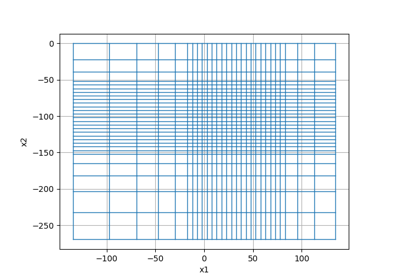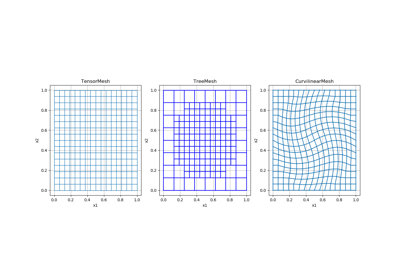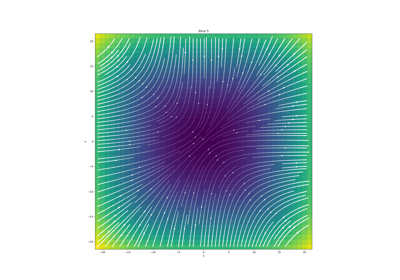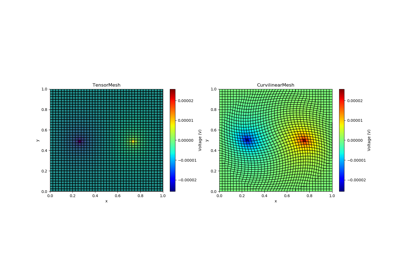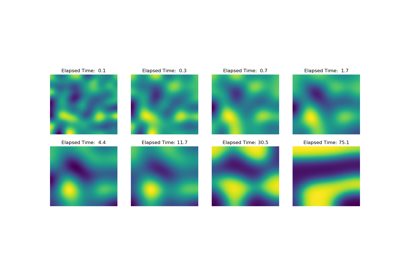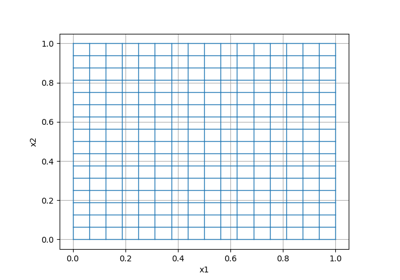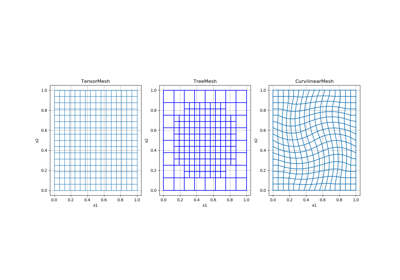discretize.TensorMesh¶
-
class
discretize.TensorMesh(h=None, x0=None, **kwargs)[source]¶ Bases:
discretize.base.base_tensor_mesh.BaseTensorMesh,discretize.base.base_mesh.BaseRectangularMesh,discretize.View.TensorView,discretize.DiffOperators.DiffOperators,discretize.InnerProducts.InnerProducts,discretize.MeshIO.TensorMeshIOTensorMesh is a mesh class that deals with tensor product meshes.
Any Mesh that has a constant width along the entire axis such that it can defined by a single width vector, called ‘h’.
import discretize hx = np.array([1, 1, 1]) hy = np.array([1, 2]) hz = np.array([1, 1, 1, 1]) mesh = discretize.TensorMesh([hx, hy, hz]) mesh.plotGrid()

Example of a padded tensor mesh using
discretize.utils.meshTensor():import discretize mesh = discretize.TensorMesh([ [(10, 10, -1.3), (10, 40), (10, 10, 1.3)], [(10, 10, -1.3), (10, 20)] ]) mesh.plotGrid()

For a quick tensor mesh on a (10x12x15) unit cube
import discretize mesh = discretize.TensorMesh([10, 12, 15])
Required Properties:
- axis_u (
Vector3): Vector orientation of u-direction. For more details see the docs for therotation_matrixproperty., a 3D Vector of <class ‘float’> with shape (3), Default: X - axis_v (
Vector3): Vector orientation of v-direction. For more details see the docs for therotation_matrixproperty., a 3D Vector of <class ‘float’> with shape (3), Default: Y - axis_w (
Vector3): Vector orientation of w-direction. For more details see the docs for therotation_matrixproperty., a 3D Vector of <class ‘float’> with shape (3), Default: Z - h (a list of
Array): h is a list containing the cell widths of the tensor mesh in each dimension., a list (each item is a list or numpy array of <class ‘float’> with shape (*)) with length between 0 and 3 - reference_system (
String): The type of coordinate reference frame. Can take on the values cartesian, cylindrical, or spherical. Abbreviations of these are allowed., a unicode string, Default: cartesian - x0 (
Array): origin of the mesh (dim, ), a list or numpy array of <class ‘float’> with shape (*)
- axis_u (
Examples using discretize.TensorMesh¶
Attributes¶
-
TensorMesh.area¶ Construct face areas of the 3D model as 1d array.
-
TensorMesh.areaFx¶ Area of the x-faces
-
TensorMesh.areaFy¶ Area of the y-faces
-
TensorMesh.areaFz¶ Area of the z-faces
-
TensorMesh.aveCC2F¶ Construct the averaging operator on cell centers to faces.
-
TensorMesh.aveCCV2F¶ Construct the averaging operator on cell centers to faces as a vector.
-
TensorMesh.aveE2CC¶ Construct the averaging operator on cell edges to cell centers.
-
TensorMesh.aveE2CCV¶ Construct the averaging operator on cell edges to cell centers.
-
TensorMesh.aveEx2CC¶ Construct the averaging operator on cell edges in the x direction to cell centers.
-
TensorMesh.aveEy2CC¶ Construct the averaging operator on cell edges in the y direction to cell centers.
-
TensorMesh.aveEz2CC¶ Construct the averaging operator on cell edges in the z direction to cell centers.
-
TensorMesh.aveF2CC¶ Construct the averaging operator on cell faces to cell centers.
-
TensorMesh.aveF2CCV¶ Construct the averaging operator on cell faces to cell centers.
-
TensorMesh.aveFx2CC¶ Construct the averaging operator on cell faces in the x direction to cell centers.
-
TensorMesh.aveFy2CC¶ Construct the averaging operator on cell faces in the y direction to cell centers.
-
TensorMesh.aveFz2CC¶ Construct the averaging operator on cell faces in the z direction to cell centers.
-
TensorMesh.aveN2CC¶ Construct the averaging operator on cell nodes to cell centers.
-
TensorMesh.aveN2E¶ Construct the averaging operator on cell nodes to cell edges, keeping each dimension separate.
-
TensorMesh.aveN2F¶ Construct the averaging operator on cell nodes to cell faces, keeping each dimension separate.
-
TensorMesh.axis_u¶ X
Type: axis_u ( Vector3)Type: Vector orientation of u-direction. For more details see the docs for the rotation_matrixproperty., a 3D Vector of <class ‘float’> with shape (3), Default
-
TensorMesh.axis_v¶ Y
Type: axis_v ( Vector3)Type: Vector orientation of v-direction. For more details see the docs for the rotation_matrixproperty., a 3D Vector of <class ‘float’> with shape (3), Default
-
TensorMesh.axis_w¶ Z
Type: axis_w ( Vector3)Type: Vector orientation of w-direction. For more details see the docs for the rotation_matrixproperty., a 3D Vector of <class ‘float’> with shape (3), Default
-
TensorMesh.cellBoundaryInd¶ Find indices of boundary faces in each direction
-
TensorMesh.cellGrad¶ The cell centered Gradient, takes you to cell faces.
-
TensorMesh.cellGradBC¶ The cell centered Gradient boundary condition matrix
-
TensorMesh.cellGradx¶ Cell centered Gradient in the x dimension. Has neumann boundary conditions.
-
TensorMesh.cellGrady¶
-
TensorMesh.cellGradz¶ Cell centered Gradient in the x dimension. Has neumann boundary conditions.
-
TensorMesh.dim¶ The dimension of the mesh (1, 2, or 3).
Returns: dimension of the mesh Return type: int
-
TensorMesh.edge¶ Construct edge legnths of the 3D model as 1d array.
-
TensorMesh.edgeCurl¶ Construct the 3D curl operator.
-
TensorMesh.edgeEx¶ x-edge lengths
-
TensorMesh.edgeEy¶ y-edge lengths
-
TensorMesh.edgeEz¶ z-edge lengths
-
TensorMesh.faceBoundaryInd¶ Find indices of boundary faces in each direction
-
TensorMesh.faceDiv¶ Construct divergence operator (face-stg to cell-centres).
-
TensorMesh.faceDivx¶ Construct divergence operator in the x component (face-stg to cell-centres).
-
TensorMesh.faceDivy¶
-
TensorMesh.faceDivz¶ Construct divergence operator in the z component (face-stg to cell-centers).
-
TensorMesh.gridCC¶ Cell-centered grid.
-
TensorMesh.gridEx¶ Edge staggered grid in the x direction.
-
TensorMesh.gridEy¶ Edge staggered grid in the y direction.
-
TensorMesh.gridEz¶ Edge staggered grid in the z direction.
-
TensorMesh.gridFx¶ Face staggered grid in the x direction.
-
TensorMesh.gridFy¶ Face staggered grid in the y direction.
-
TensorMesh.gridFz¶ Face staggered grid in the z direction.
-
TensorMesh.gridN¶ Nodal grid.
-
TensorMesh.h¶ h is a list containing the cell widths of the tensor mesh in each dimension., a list (each item is a list or numpy array of <class ‘float’> with shape (*)) with length between 0 and 3
Type: h (a list of Array)
-
TensorMesh.h_gridded¶ Returns an (nC, dim) numpy array with the widths of all cells in order
-
TensorMesh.hx¶ Width of cells in the x direction
-
TensorMesh.hy¶ Width of cells in the y direction
-
TensorMesh.hz¶ Width of cells in the z direction
-
TensorMesh.nE¶ Total number of edges.
Returns: nE Return type: int = sum([nEx, nEy, nEz])
-
TensorMesh.nodalGrad¶ Construct gradient operator (nodes to edges).
-
TensorMesh.nodalLaplacian¶ Construct laplacian operator (nodes to edges).
-
TensorMesh.normals¶ Face Normals
Return type: numpy.ndarray Returns: normals, (sum(nF), dim)
-
TensorMesh.reference_is_rotated¶ True if the axes are rotated from the traditional <X,Y,Z> system with vectors of \((1,0,0)\), \((0,1,0)\), and \((0,0,1)\)
-
TensorMesh.reference_system¶ cartesian
Type: reference_system ( String)Type: The type of coordinate reference frame. Can take on the values cartesian, cylindrical, or spherical. Abbreviations of these are allowed., a unicode string, Default
-
TensorMesh.rotation_matrix¶ Builds a rotation matrix to transform coordinates from their coordinate system into a conventional cartesian system. This is built off of the three axis_u, axis_v, and axis_w properties; these mapping coordinates use the letters U, V, and W (the three letters preceding X, Y, and Z in the alphabet) to define the projection of the X, Y, and Z durections. These UVW vectors describe the placement and transformation of the mesh’s coordinate sytem assuming at most 3 directions.
Why would you want to use these UVW mapping vectors the this rotation_matrix property? They allow us to define the realationship between local and global coordinate systems and provide a tool for switching between the two while still maintaing the connectivity of the mesh’s cells. For a visual example of this, please see the figure in the docs for the
vtkInterface.
-
TensorMesh.tangents¶ Edge Tangents
Return type: numpy.ndarray Returns: normals, (sum(nE), dim)
-
TensorMesh.vectorCCx¶ Cell-centered grid vector (1D) in the x direction.
-
TensorMesh.vectorCCy¶ Cell-centered grid vector (1D) in the y direction.
-
TensorMesh.vectorCCz¶ Cell-centered grid vector (1D) in the z direction.
-
TensorMesh.vectorNx¶ Nodal grid vector (1D) in the x direction.
-
TensorMesh.vectorNy¶ Nodal grid vector (1D) in the y direction.
-
TensorMesh.vectorNz¶ Nodal grid vector (1D) in the z direction.
-
TensorMesh.vnC¶ Total number of cells in each direction
Return type: numpy.ndarray Returns: [nCx, nCy, nCz]
-
TensorMesh.vnE¶ Total number of edges in each direction
Returns: - vnE (numpy.ndarray = [nEx, nEy, nEz], (dim, ))
- .. plot:: – :include-source:
import discretize import numpy as np M = discretize.TensorMesh([np.ones(n) for n in [2,3]]) M.plotGrid(edges=True, showIt=True)
-
TensorMesh.vnEx¶ Number of x-edges in each direction
Return type: numpy.ndarray Returns: vnEx
-
TensorMesh.vnEy¶ Number of y-edges in each direction
Return type: numpy.ndarray Returns: vnEy or None if dim < 2
-
TensorMesh.vnEz¶ Number of z-edges in each direction
Return type: numpy.ndarray Returns: vnEz or None if dim < 3
-
TensorMesh.vnF¶ Total number of faces in each direction
Return type: numpy.ndarray Returns: [nFx, nFy, nFz], (dim, ) import discretize import numpy as np M = discretize.TensorMesh([np.ones(n) for n in [2,3]]) M.plotGrid(faces=True, showIt=True)

-
TensorMesh.vnFx¶ Number of x-faces in each direction
Return type: numpy.ndarray Returns: vnFx
-
TensorMesh.vnFy¶ Number of y-faces in each direction
Return type: numpy.ndarray Returns: vnFy or None if dim < 2
-
TensorMesh.vnFz¶ Number of z-faces in each direction
Return type: numpy.ndarray Returns: vnFz or None if dim < 3
-
TensorMesh.vnN¶ Total number of nodes in each direction
Return type: numpy.ndarray Returns: [nNx, nNy, nNz]
-
TensorMesh.vol¶ Construct cell volumes of the 3D model as 1d array.
Methods¶
-
TensorMesh.copy()¶ Make a copy of the current mesh
-
classmethod
TensorMesh.deserialize(value, trusted=False, strict=False, assert_valid=False, **kwargs)¶ Creates HasProperties instance from serialized dictionary
This uses the Property deserializers to deserialize all JSON-compatible dictionary values into their corresponding Property values on a new instance of a HasProperties class. Extra keys in the dictionary that do not correspond to Properties will be ignored.
Parameters:
- value - Dictionary to deserialize new instance from.
- trusted - If True (and if the input dictionary has
'__class__'keyword and this class is in the registry), the new HasProperties class will come from the dictionary. If False (the default), only the HasProperties class this method is called on will be constructed. - strict - Requires
'__class__', if present on the input dictionary, to match the deserialized instance’s class. Also disallows unused properties in the input dictionary. Default is False. - assert_valid - Require deserialized instance to be valid. Default is False.
- Any other keyword arguments will be passed through to the Property deserializers.
-
TensorMesh.equal(other)¶ Determine if two HasProperties instances are equivalent
Equivalence is determined by checking if all Property values on two instances are equal, using
Property.equal.
-
TensorMesh.getBCProjWF(BC, discretization='CC')¶ The weak form boundary condition projection matrices.
Example
# Neumann in all directions BC = 'neumann' # 3D, Dirichlet in y Neumann else BC = ['neumann', 'dirichlet', 'neumann'] # 3D, Neumann in x on bottom of domain, Dirichlet else BC = [['neumann', 'dirichlet'], 'dirichlet', 'dirichlet']
-
TensorMesh.getBCProjWF_simple(discretization='CC')¶ The weak form boundary condition projection matrices when mixed boundary condition is used
-
TensorMesh.getEdgeInnerProduct(prop=None, invProp=False, invMat=False, doFast=True)¶ Generate the edge inner product matrix
Parameters: - prop (numpy.ndarray) – material property (tensor properties are possible) at each cell center (nC, (1, 3, or 6))
- invProp (bool) – inverts the material property
- invMat (bool) – inverts the matrix
- doFast (bool) – do a faster implementation if available.
Returns: M, the inner product matrix (nE, nE)
Return type:
-
TensorMesh.getEdgeInnerProductDeriv(prop, doFast=True, invProp=False, invMat=False)¶ Parameters: - prop (numpy.ndarray) – material property (tensor properties are possible) at each cell center (nC, (1, 3, or 6))
- doFast (bool) – do a faster implementation if available.
- invProp (bool) – inverts the material property
- invMat (bool) – inverts the matrix
Returns: dMdm, the derivative of the inner product matrix (nE, nC*nA)
Return type:
-
TensorMesh.getFaceInnerProduct(prop=None, invProp=False, invMat=False, doFast=True)¶ Generate the face inner product matrix
Parameters: - prop (numpy.ndarray) – material property (tensor properties are possible) at each cell center (nC, (1, 3, or 6))
- invProp (bool) – inverts the material property
- invMat (bool) – inverts the matrix
- doFast (bool) – do a faster implementation if available.
Returns: M, the inner product matrix (nF, nF)
Return type:
-
TensorMesh.getFaceInnerProductDeriv(prop, doFast=True, invProp=False, invMat=False)¶ Parameters: - prop (numpy.ndarray) – material property (tensor properties are possible) at each cell center (nC, (1, 3, or 6))
- doFast – bool do a faster implementation if available.
- invProp (bool) – inverts the material property
- invMat (bool) – inverts the matrix
Returns: dMdmu(u), the derivative of the inner product matrix for a certain u
Return type:
-
TensorMesh.getInterpolationMat(loc, locType='CC', zerosOutside=False)¶ Produces interpolation matrix
Parameters: - loc (numpy.ndarray) – Location of points to interpolate to
- locType (str) –
What to interpolate (see below)
locType can be:
'Ex' -> x-component of field defined on edges 'Ey' -> y-component of field defined on edges 'Ez' -> z-component of field defined on edges 'Fx' -> x-component of field defined on faces 'Fy' -> y-component of field defined on faces 'Fz' -> z-component of field defined on faces 'N' -> scalar field defined on nodes 'CC' -> scalar field defined on cell centers 'CCVx' -> x-component of vector field defined on cell centers 'CCVy' -> y-component of vector field defined on cell centers 'CCVz' -> z-component of vector field defined on cell centers
Returns: M, the interpolation matrix
Return type:
-
TensorMesh.getTensor(key)¶ Returns a tensor list.
Parameters: key (str) – Which tensor (see below)
key can be:
'CC' -> scalar field defined on cell centers 'N' -> scalar field defined on nodes 'Fx' -> x-component of field defined on faces 'Fy' -> y-component of field defined on faces 'Fz' -> z-component of field defined on faces 'Ex' -> x-component of field defined on edges 'Ey' -> y-component of field defined on edges 'Ez' -> z-component of field defined on edges
Returns: list of the tensors that make up the mesh. Return type: list
-
TensorMesh.isInside(pts, locType='N')¶ Determines if a set of points are inside a mesh.
Parameters: pts (numpy.ndarray) – Location of points to test Return type: numpy.ndarray Returns: inside, numpy array of booleans
-
TensorMesh.plotGrid(ax=None, nodes=False, faces=False, centers=False, edges=False, lines=True, showIt=False, **kwargs)¶ Plot the nodal, cell-centered and staggered grids for 1,2 and 3 dimensions.
Parameters: import discretize import numpy as np h1 = np.linspace(.1, .5, 3) h2 = np.linspace(.1, .5, 5) mesh = discretize.TensorMesh([h1, h2]) mesh.plotGrid(nodes=True, faces=True, centers=True, lines=True, showIt=True)
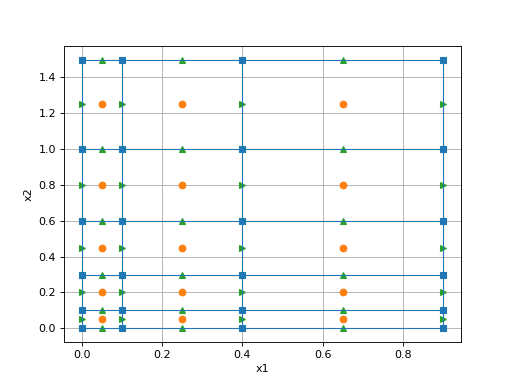
import discretize import numpy as np h1 = np.linspace(.1, .5, 3) h2 = np.linspace(.1, .5, 5) h3 = np.linspace(.1, .5, 3) mesh = discretize.TensorMesh([h1, h2, h3]) mesh.plotGrid(nodes=True, faces=True, centers=True, lines=True, showIt=True)
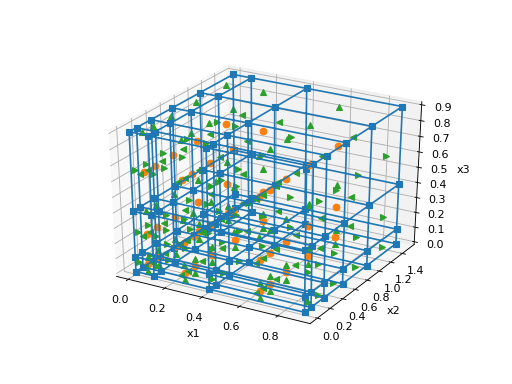
-
TensorMesh.plotImage(v)¶ Plots scalar fields on the given mesh.
Input:
Parameters: v (numpy.ndarray) – vector Optional Inputs:
Parameters: - vType (str) – type of vector (‘CC’, ‘N’, ‘F’, ‘Fx’, ‘Fy’, ‘Fz’, ‘E’, ‘Ex’, ‘Ey’, ‘Ez’)
- ax (matplotlib.axes.Axes) – axis to plot to
- showIt (bool) – call plt.show()
3D Inputs:
Parameters: import discretize import numpy as np M = discretize.TensorMesh([20, 20]) v = np.sin(M.gridCC[:, 0]*2*np.pi)*np.sin(M.gridCC[:, 1]*2*np.pi) M.plotImage(v, showIt=True)
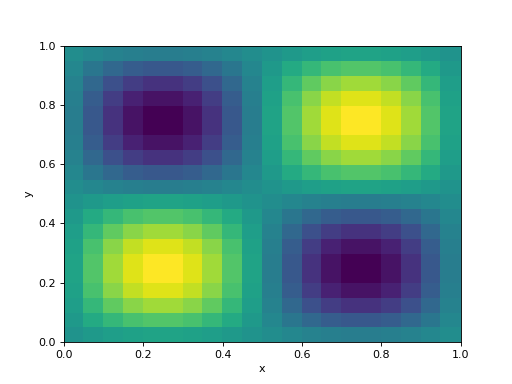
import discretize import numpy as np M = discretize.TensorMesh([20, 20, 20]) v = np.sin(M.gridCC[:, 0]*2*np.pi)*np.sin(M.gridCC[:, 1]*2*np.pi)*np.sin(M.gridCC[:, 2]*2*np.pi) M.plotImage(v, annotationColor='k', showIt=True)

-
TensorMesh.plotSlice(v, vType='CC', normal='Z', ind=None, grid=False, view='real', ax=None, clim=None, showIt=False, pcolorOpts=None, streamOpts=None, gridOpts=None, range_x=None, range_y=None, sample_grid=None, stream_threshold=None, stream_thickness=None)¶ Plots a slice of a 3D mesh.
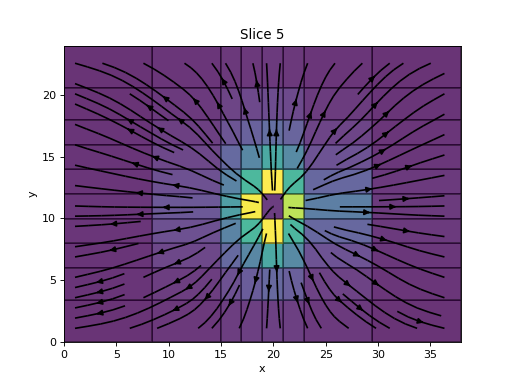
-
TensorMesh.plot_3d_slicer(v, xslice=None, yslice=None, zslice=None, vType='CC', view='real', axis='xy', transparent=None, clim=None, aspect='auto', grid=[2, 2, 1], pcolorOpts=None)¶ Plot slices of a 3D volume, interactively (scroll wheel).
If called from a notebook, make sure to set
%matplotlib notebookSee the class discretize.View.Slicer for more information.
It returns nothing. However, if you need the different figure handles you can get it via
fig = plt.gcf()and subsequently its children via
fig.get_children()and recursively deeper, e.g.,
fig.get_children()[0].get_children().
-
TensorMesh.projectEdgeVector(eV)¶ Given a vector, eV, in cartesian coordinates, this will project it onto the mesh using the tangents
Parameters: eV (numpy.ndarray) – edge vector with shape (nE, dim) Return type: numpy.ndarray Returns: projected edge vector, (nE, )
-
TensorMesh.projectFaceVector(fV)¶ Given a vector, fV, in cartesian coordinates, this will project it onto the mesh using the normals
Parameters: fV (numpy.ndarray) – face vector with shape (nF, dim) Return type: numpy.ndarray Returns: projected face vector, (nF, )
-
TensorMesh.r(x, xType='CC', outType='CC', format='V')¶ r is a quick reshape command that will do the best it can at giving you what you want.
For example, you have a face variable, and you want the x component of it reshaped to a 3D matrix.
r can fulfil your dreams:
mesh.r(V, 'F', 'Fx', 'M') | | | | | | | { | | | How: 'M' or ['V'] for a matrix | | | (ndgrid style) or a vector (n x dim) | | | } | | { | | What you want: ['CC'], 'N', | | 'F', 'Fx', 'Fy', 'Fz', | | 'E', 'Ex', 'Ey', or 'Ez' | | } | { | What is it: ['CC'], 'N', | 'F', 'Fx', 'Fy', 'Fz', | 'E', 'Ex', 'Ey', or 'Ez' | } { The input: as a list or ndarray }
For example:
# Separates each component of the Ex grid into 3 matrices Xex, Yex, Zex = r(mesh.gridEx, 'Ex', 'Ex', 'M') # Given an edge vector, return just the x edges as a vector XedgeVector = r(edgeVector, 'E', 'Ex', 'V') # Separates each component of the edgeVector into 3 vectors eX, eY, eZ = r(edgeVector, 'E', 'E', 'V')
-
TensorMesh.readModelUBC(fileName, directory='')¶ - Read UBC 2D or 3D Tensor mesh model
- and generate Tensor mesh model
Input: :param str fileName: path to the UBC GIF mesh file to read or just its name if directory is specified :param str directory: directory where the UBC GIF file lives
Output: :rtype: numpy.ndarray :return: model with TensorMesh ordered
-
classmethod
TensorMesh.readUBC(fileName, directory='')¶ Wrapper to Read UBC GIF 2D and 3D tensor mesh and generate same dimension TensorMesh.
Input: :param str fileName: path to the UBC GIF mesh file or just its name if directory is specified :param str directory: directory where the UBC GIF file lives
Output: :rtype: TensorMesh :return: The tensor mesh for the fileName.
-
classmethod
TensorMesh.readVTK(fileName, directory='')¶ Read VTK Rectilinear (vtr xml file) and return Tensor mesh and model
Parameters: Returns: (TensorMesh, modelDictionary)
Return type:
-
TensorMesh.save(filename='mesh.json', verbose=False)¶ Save the mesh to json :param str file: filename for saving the casing properties :param str directory: working directory for saving the file
-
TensorMesh.serialize(include_class=True, save_dynamic=False, **kwargs)¶ Serializes a HasProperties instance to dictionary
This uses the Property serializers to serialize all Property values to a JSON-compatible dictionary. Properties that are undefined are not included. If the HasProperties instance contains a reference to itself, a
properties.SelfReferenceErrorwill be raised.Parameters:
- include_class - If True (the default), the name of the class
will also be saved to the serialized dictionary under key
'__class__' - save_dynamic - If True, dynamic properties are written to the serialized dict (default: False).
- Any other keyword arguments will be passed through to the Property serializers.
- include_class - If True (the default), the name of the class
will also be saved to the serialized dictionary under key
-
TensorMesh.setCellGradBC(BC)¶ Function that sets the boundary conditions for cell-centred derivative operators.
Example
..code:: python
# Neumann in all directions BC = ‘neumann’
# 3D, Dirichlet in y Neumann else BC = [‘neumann’, ‘dirichlet’, ‘neumann’]
# 3D, Neumann in x on bottom of domain, Dirichlet else BC = [[‘neumann’, ‘dirichlet’], ‘dirichlet’, ‘dirichlet’]
-
TensorMesh.toVTK(models=None)¶ Convert this mesh object to it’s proper
vtkidata object with the given model dictionary as the cell data of that dataset.Parameters: models (dict(numpy.ndarray)) – Name(‘s) and array(‘s). Match number of cells
-
TensorMesh.validate()¶ Call all registered class validator methods
These are all methods decorated with
@properties.validator. Validator methods are expected to raise a ValidationError if they fail.
-
TensorMesh.writeModelUBC(fileName, model, directory='')¶ Writes a model associated with a TensorMesh to a UBC-GIF format model file.
Input: :param str fileName: File to write to or just its name if directory is specified :param str directory: directory where the UBC GIF file lives :param numpy.ndarray model: The model
-
TensorMesh.writeUBC(fileName, models=None, directory='', comment_lines='')¶ Writes a TensorMesh to a UBC-GIF format mesh file.
Input: :param str fileName: File to write to :param str directory: directory where to save model :param dict models: A dictionary of the models :param str comment_lines: comment lines preceded with ‘!’ to add
-
TensorMesh.writeVTK(fileName, models=None, directory='')¶ Makes and saves a VTK object from this mesh and given models
Parameters:
